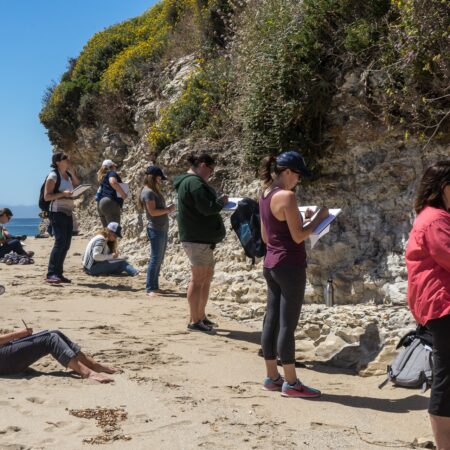 “I have never felt so inspired and proud to be an educator,” said Brian Boyce, teacher at Santa Cruz Gardens Elementary School. From a look around the crowded room and the buzz of conversation, this seemed to be a sentiment shared among the TK-12 teachers who gathered Saturday to share and celebrate their students’ environmental action projects as part of Santa Cruz COE’s new Teacher Leadership Institute for Sustainability. Mr. Boyce’s 5th grade class project is designing and installing a more efficient irrigation system for their student created garden.
“I have never felt so inspired and proud to be an educator,” said Brian Boyce, teacher at Santa Cruz Gardens Elementary School. From a look around the crowded room and the buzz of conversation, this seemed to be a sentiment shared among the TK-12 teachers who gathered Saturday to share and celebrate their students’ environmental action projects as part of Santa Cruz COE’s new Teacher Leadership Institute for Sustainability. Mr. Boyce’s 5th grade class project is designing and installing a more efficient irrigation system for their student created garden.
The professional learning program celebrated completion of its first cohort this week after launching in January 2023 with the goal of building the capacity of TK-12th grade teachers to integrate environmental sustainability, outdoor learning, and student-driven environmental action projects into their core curriculum. The Institute drew applicants from school districts across the county and will continue to add teachers over the next two years thanks to a grant from NOAA’s Bay-Watershed Education Training Program. Content areas represented in the teacher cohort included Science, English Language Arts, Math, English Language Development, Library Media, Health and Physical Education.
“Santa Cruz County Office of Education, our school districts and our community-based environmental education partners are working together toward a shared goal of providing each and every student with experiences that empower them to be changemakers for our environment. Learning about environmental systems connects to all content areas,” said Amity Sandage, Santa Cruz COE’s Environmental Literacy Coordinator. “And the outdoor learning that is part of the Teacher Leadership Institute program builds students’ sense of connection and joy in nature while offering a living laboratory for students to apply new knowledge and meaningful problem solving in real world settings.”
Teachers agree: “It was awesome to see the students really taking ownership of their school campus. They were excited to offer their ideas and suggestions for how to increase green spaces on campus, habitat for wildlife, and mitigate impacts of construction. Also, I felt really proud of how they were able to transfer the concepts they learned in the classroom to this real-world scenario,” said Allison Seletzky, San Lorenzo Valley Middle School science teacher, who collaborated with English teachers at her school to engage students in gathering data and conducting research to write an Environmental Impact Report on construction at their school.
At the start of the program, teacher participants asked for examples of how this work is done and found there was not a lot out there. Now they are the ones providing the blueprints for others to follow. Check out their Green Classroom Profiles at the “Every Classroom a Green Classroom” Teacher Leadership Institute for Sustainability website to read their stories and the impact on students:
“I had no idea we could create something that would do so much good in our community.” –Sofia, 4th grade student
